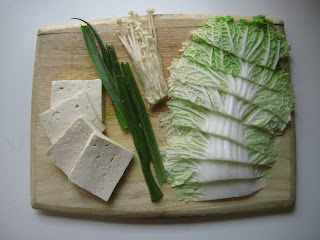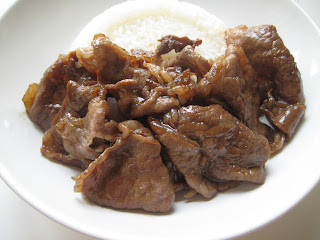 The window I moved it to now isn't North-facing either. It turns out there are no North-facing windows at all in my office. How sad. This window is at least next to my desk.
The window I moved it to now isn't North-facing either. It turns out there are no North-facing windows at all in my office. How sad. This window is at least next to my desk. Anyway, a week in, and no sprouts yet. We'll see.
Anyway, a week in, and no sprouts yet. We'll see.---
So I've decided to make a couple Japanese dishes every weekend. Today's dish is sukiyaki, a style of nabemono, or "steamboat," the Japanese take on the hot pot, where thinly sliced meats are simmered with vegetables in a dashi broth.
Dashi is made by boiling together konbu, a type of edible kelp, and kezurikatsuo, shavings of dried tuna more commonly known as bonito. The resulting broth forms the base of many dishes, such as miso soup, noodle broths, and of course, nabemono soups.
Many consider dashi to be fundamental to Japanese cuisine. Shizuo Tsuji, author of Japanese Cooking, A Simple Art, writes, "many substitutes for dashi are possible, but without dashi, dishes are merely a la japonaise and lack the authentic flavor."
Thus, I was willing to bike 8 miles to a Nijiya Market to get some.
"Osen"-style sukiyaki comes from a great Japanese television series "Osen," which is about a traditional Japanese restaurant and its struggles in facing modernization. The way they prepare sukiyaki in the series is a step away from what I've seen before, but it was intriguing, so I thought I'd prepare sukiyaki today in that way.

It starts with the beef. This is prime rib-eye, sliced thin. $19.99/lb at Nijiya Market. Expensive as balls, but I biked 8 miles to get there, so I figured what the hell.

These are the vegetables that will go in later. From left to right: firm tofu, scallions, enoki mushrooms, and napa cabbage. In the show, they use just fried tofu and another vegetable called shungiku, which are garland chrysanthemum leaves. Traditional sukiyaki also uses this (as do many Chinese hot pot dishes), but I'm personally not a big fan, as they're relatively bitter.
 Here is where Osen-style sukiyaki differs from traditional sukiyaki, and also where I differ from Osen-style sukiyaki. In the series, they use a clay pot instead of a soup pot. I don't have a clay pot, so I'm using my mini-teppan grill. Also, rather than make the soup and cook the vegetables first, Osen-style sukiyaki browns the meat first.
Here is where Osen-style sukiyaki differs from traditional sukiyaki, and also where I differ from Osen-style sukiyaki. In the series, they use a clay pot instead of a soup pot. I don't have a clay pot, so I'm using my mini-teppan grill. Also, rather than make the soup and cook the vegetables first, Osen-style sukiyaki browns the meat first. Traditionally, onions are browned in butter before the broth and other vegetables are added. And the meat actually goes in last.
Traditionally, onions are browned in butter before the broth and other vegetables are added. And the meat actually goes in last.
Here we are browning the meat first, almost like teppanyaki, a form of Japanese bbq where meats and vegetables are cooked on an iron griddle.

When the meat reaches medium-rare, that is when we add the sukiyaki sauce, which is a combination of soy sauce, sugar, and mirin (Japanese rice wine). Japanese markets usually have pre-mixed sukiyaki sauces.

The meat is simmered in the sauce for just a moment, and then removed.

In both the Osen-style and traditional sukiyaki, this meat (as well as the vegetables that are cooked later), are dipped in raw egg, and then eaten. I'm not too big on raw egg, so I just serve it over a steaming bowl of white rice.

Nom.

In Osen, the dashi broth is then added to the pot that the beef was cooked in, picking up all the meat juices and the remaining sauce. Unfortunately, my mini-teppan grill was a little shallow, so I had to mix a little of the broth in to pick up the sauce and juice, and then transfer that over to a taller soup pot.
The vegetables are then added. The noodles on the top are yam noodles called shirataki noodles. They're much chewier than noodles such as ramen or udon.

Covering and simmering lets all the flavors meld together. Especially in the tofu. In traditinal sukiyaki, the tofu is seared before stewing in the broth, and in Osen-style sukiyaki, the tofu is deep fried. These methods provide the tofu with a firmer texture on the outside, preventing the tofu from just falling apart as you try to pick it up. I just prefer straight up tofu, but it's all good~

With some of my leftover meat added back in because it had cooled, this is what traditional sukiyaki would look like. The raw meat is added at the very end, after the broth and vegetables have simmered away, and cooked to a medium rare-state, and eaten immediately.
I personally prefer the Osen-style where the meat is cooked first, as it allows for a slight char on the outside of the meat, but it is a little troublesome, especially in my case, where I had to switch pots.

Regardless, it was awesome, especially with a bottle of Calpico~

No comments:
Post a Comment